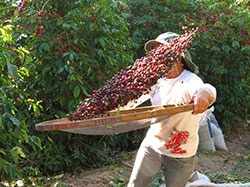- Home
- Vietnamese Phin Filters
Vietnamese Phin Filters
Vietnamese Phin filters can be purchased here.
These filters are great for people who don't have room for a coffee machine or who like to make a single cup at a time. All you need is hot water and this filter kit. If you want to brew iced coffee, follow the same instructions but put the filter assembly over a cup with cubed or crushed ice.
Pictorical Instructions:
 The kit includes the filter chamber, filter press, cup spanner, and cap. Some people prefer a glass mug or cup because they can watch the progress of the brewing.
The kit includes the filter chamber, filter press, cup spanner, and cap. Some people prefer a glass mug or cup because they can watch the progress of the brewing.
This method takes about 4-6 minutes from start to finish, if you have the right amount of coffee and the right grind. If it drips too fast, add more coffee or make the grind finer. If it brews too slow, make the grind coarser or use less coffee.
Typically you should use a rounded tablespoon of coffee to start, and then adjust from there if the time is not right.
 We recommend pre-heating the cup with a little hot water, because a lot of heat is lost in the small filter, and it is good to keep the coffee heat from going into heating the cup.
We recommend pre-heating the cup with a little hot water, because a lot of heat is lost in the small filter, and it is good to keep the coffee heat from going into heating the cup.
Put the coffee in the empty chamber of the filter. Tap the chamber a little to settle it so it will drain evenly. Put the chamber and the wide saucer spanner section over the cup you will be brewing into.
Put the insert inside on top of the coffee as shown and spin the insert once or twice to even out the coffee. Then, pour in a little water (a couple of tablespoons) to moisten and swell the coffee.
 Wait about 20 seconds, then fill the chamber with hot water. The best temperature is 185° to 195°.
Wait about 20 seconds, then fill the chamber with hot water. The best temperature is 185° to 195°.
Place the lid on top and wait about 3 minutes for the water to drip through the grinds. Lift the lid to check on progress.
 The best flavor is achieved in about 4 minutes. Water that drips through after that time may not be adding a lot of flavor to the coffee, so that is why it is best to adjust the amount of coffee to make it about a 4-minute brew.
The best flavor is achieved in about 4 minutes. Water that drips through after that time may not be adding a lot of flavor to the coffee, so that is why it is best to adjust the amount of coffee to make it about a 4-minute brew.
When the chamber is empty, lift the filter assembly off the cup and turn the lid upside down, then place the filter assembly on it. The remaining drips of water will collect in the lid and keep your table clean.
Problems?
Using the filter should be simple and easy. If you're having any trouble with it, here are some common issues and their solutions:
- Coffee takes more than 4 minutes to brew: You might be using too much coffee. Just use one tablespoon. If you're already using the correct amount, you might be grinding the coffee too fine. Try cutting your grinding short by a few seconds and see if that helps. Remember, you don't need to press the filter insert down or otherwise try to compact the coffee; gravity is all that is necessary for a perfect brew.
- Coffee brews in less than 4 minutes: You might be using too little coffee, or not grinding the coffee coarsely enough. Try using a little more coffee or grinding it a little finer. If you want the coffee to be less strong, it's better to dilute it after brewing it; trying to weaken it by using less coffee produces a less-flavorful brew.
- Water overflows the filter: Just use less water! This little filter makes only about 6 ounces of coffee, but it's intense and flavorful. If you want more, just brew another cup. Or, consider buying a French Coffee Press, which produces excellent results in larger quantities.
- Coffee gets cold: Try heating up your cup before brewing; you can try using your dishwasher's "Platewarmer" setting or else pour boiling-hot water into it, letting it sit for a minute, and then pouring it out and starting to brew.
Latest Coffee Addition

Colombian Castillo Heritage Arabica!
Coffee from the days when Colombian coffee defined American consumer tastes. Warm, rich, delicious! Read more here!
 Loading... Please wait...
Loading... Please wait...


